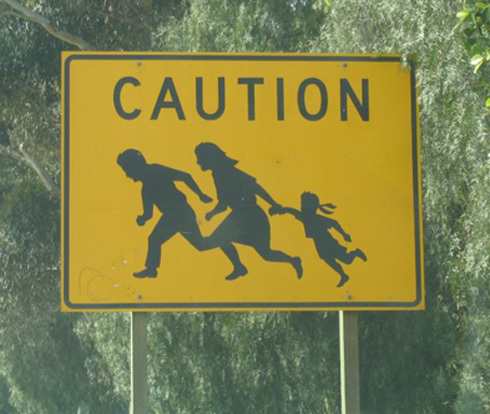Immigrant Crossing Road Sign

Annotation
Interstate 5 runs from the Mexican/U.S. border crossing at San Ysidro, California, to the Peace Arch Crossing into Canada at Blaine, Washington. This official yellow warning road sign is posted along Interstate 5 near the San Ysidro crossing and north of San Diego. The sign shows a man and a woman running as the woman pulls a girl with pigtails along, her feet barely touching the ground. San Ysidro is the world's busiest land border crossing, with more than 17 million vehicles and 50 million people crossing legally in 2005. The California Department of Transportation, or Caltrans, developed this warning sign after more than 100 undocumented immigrants were killed on the highway, especially near border control points. After trying a wordy and ineffective sign that read, "Caution Watch for People Crossing Road," Caltrans assigned graphic artist John Hood, a Vietnam veteran of Navaho parentage, to develop the new sign. Posted in 1990, it quickly became a cultural icon for those who tolerate and those who oppose immigration, both legal and illegal.
Migration in borderlands such as the California/Mexico crossing have attracted academic attention as a phenomenon of globalization. In 1990 and 1991, almost 3.5 million immigrants were admitted legally to the United States—a number larger than at any previous point in American history, and as of 2009, over 25 million people in the U.S. are foreign born, excluding illegal immigrants. In some urban Southern California counties, the majority of residents are immigrants, and many of these are children who require schooling, health care, and other services. Academic study of immigration tracks both the reception of immigrants among the resident population, and the interaction of the immigrants with the destination country. Of the 24 million Americans in the United States today who migrated since 1960, 40% came as children.
The phenomenon of migration is as old as the evolution of human beings, which predates even the concept of world history. The interlocking relationship between human evolution, migration and the diaspora is best understood through the migratory nature of humans; a significant epoch in world history. The scientific evolution of humans, beginning with the oldest man-ape; Homo Habilis, Homo Erectus, Homo Heidelbergensis to the modern Homo Sapiens all reflected the necessity of migration for survival and security. The United States of America has been known as the world largest migrant destination which hosts a conglomerate of world migrant communities from Asia, Africa, Europe and the Middle East.
This source is a part of the Primer: Migration and Diaspora in World History methods module.
Text
. . . The assignment to create the road sign landed on the desk of Caltrans graphic artist John Hood in the late 1980s. He was asked to design an image that, in the blink of an eye, would alert drivers to the unexpected sight of pedestrians in their headlights. Before Hood began drawing the sign, he and his supervisors met with Highway Patrol officers and saw photos of accident scenes. What got to him most were the deaths that involved families. "Graphically, I wanted to show a family," said Hood, who lives in San Diego. He chose to include a pigtailed girl, rather than a boy, because "there is something about a little girl running across with her parents that we are more affected by."
At first he drew detailed figures, with faces that showed "a little bit of fright." But, in the end, Hood and his supervisors decided on a silhouette. "When you are looking through headlights, that is what you see," Hood said, "an outline of the image itself." As he sketched, Hood tried to imagine the despair that might drive such a family across the border and onto a forbidding foreign highway. He drew from his own experience fighting in Vietnam, where he had seen families run for their lives as villages were attacked. He remembered stories his Navajo parents had told him about ancestors who died trying to escape as U.S. soldiers marched them onto reservations.
The drawing was finished in a week. Even without faces, the characters conveyed a sense of urgency in their flight. "It doesn't just mean they are running across the freeway," Hood said. "It means they are running from something else as well. I think it's a struggle for a lot of things, for opportunities, for freedom."
Credits
Leslie Berestein, "Highway safety sign becomes running story on immigration," The San Diego Union Tribune, April 10, 2005. (accessed July 1, 2009). Photograph by permission, Copyright Roger J. Wendell, http://www.rogerwendell.com/images/photography/immigrant_crossing_san_diego_03-18-2004.jpg (accessed July 1, 2009).